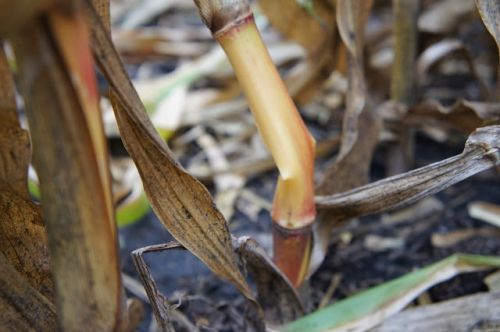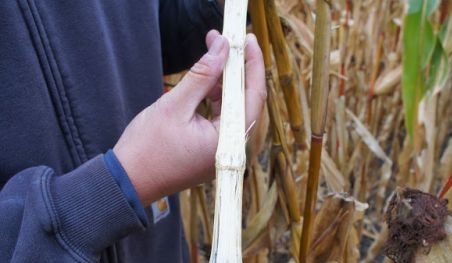Harvesting and Storing Drought-Stressed Corn
My favorite hybrids are lodging this fall…what is going on? Why is your favorite hybrid from the last few years not standing as well this fall?
After a cool, wet planting season, followed by a dry growing season, followed by a cold, wet harvest season, we’re all eager to see how our corn performs. We are hoping for the best, but the crop isn’t standing as well, and I can’t get there fast enough with the combine…aaahhh! Does this sound familiar? Let’s talk about the “why’s” of this situation, and why you shouldn’t make any rash decisions about your favorite hybrid.
Comparing the last two years can put perspective on two opposite “perfect storms” in relation to late season stalk quality. Last year, we had a warm, dry planting season, followed by a warm, dry growing season and early harvest. We had the luxury of good subsoil moisture, and the corn roots never really became stressed.
A big difference between the last two years is corn plant health at harvest. Many corn growers may be dealing with stalk lodging and stalk rots, which can lower yields. Stalk rots may also cause grain storage issues if grain quality is compromised as a result of drought stress. Understanding stalk rots can help you manage the harvest and storage of lodged corn.
The 2013 growing season is a classic example of why stalk rots are an issue this fall. The wet spring created a shallow root system. A dry growing season with depleted subsoil moisture followed, and our corn crop became drought-stressed. Stalk rots often develop when good growing conditions early in the season are followed by stress after pollination. Stresses can include lack of moisture, nitrogen deficiency, hail damage, and prolonged cool, cloudy weather. Extended periods of dry or wet weather prior to pollination, followed by abrupt changes after silking are ideal conditions for stalk rot development. This is exactly what our corn crop experienced this year.
Stalk rots can cause potential yield losses of 5 to 20%. My main tip for growers is to harvest fields in order of stalk quality instead of harvesting in order of planting date. Do a quick inspection by walking your corn fields, pushing the stalks to see if they break or are weak. Shake the stalk to see if the ears fall off. Stressed corn can weaken shanks as well as the stalks. Although drying cost is a concern, this expense is likely a better option than potential yield loss due to increased lodging. To help prevent losses while harvesting or storing corn, we’ve included some harvest tips:
- Harvest against the angle of the lodged corn to help maximize lift into the header. Slow down.
- Avoid over-threshing. Cracked or chaffy corn stores poorly, so avoid cracking the kernels.
- Drought-stressed corn usually has small kernels on ear tips. Don’t save these if it means cracking the normal kernels in the process.
Stressed corn can be delayed in drydown. Harvesting wetter corn can be challenging depending on your drying system. Poor quality grain stores poorly. Lighter test weight, chaffy kernels are much harder to keep in condition, so once the crop is harvested, there is still a risk for loss. No matter your grain quality, the following tips will help minimize storage losses when filling your bins at harvest:
- Do not leave wet corn in wagons or trucks for longer than six hours. Dry wet grain or put it in a holding bin for drying using forced air to keep it cool. Dry to 16% within 24 hours and cool to the outside air temperature within 48 hours.
- Limit the time high-moisture corn is stored in a wet bin; mold growth can begin within 24 hours and accelerates rapidly. Storing wet grain without aeration for one to two days can decrease storage life by two to three months. Aeration helps corn reach a uniform temperature and avoid “hot spots”.
- Check moisture content of every load and reset dryer controls based on changing moisture levels.
- Screen the grain going into your bins. If you do not screen your grain, pull out the cores after filling to eliminate the fines that accumulate in the middle during filling. This is the number one problem area that inhibits air flow and creates hot spots.
- Check stored corn frequently. Inspect every one to two weeks in the fall and spring; after conditions in the bin have stabilized during the winter, inspect corn once every two to four weeks. Keep the grain temperature close to ambient (outside) temperature to eliminate condensation and spoilage on bin walls.
There are many stalk rots affecting corn stands this fall. Harvest fields in order of stalk quality rather than planting order. Scout the fields for stalk lodging to avoid a surprise in the combine with downed corn.
Don’t be too quick to judge a hybrid that isn’t standing as well as it has in the past. It took the perfect storm to create the issue, and you may be giving up on a hybrid that should stay on your farm next year. Lastly, if you have lower test weight chaffy corn, be careful of the storage issues associated with it.






